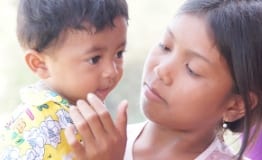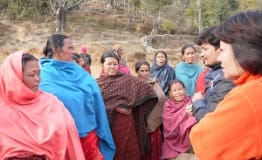Issues the Project Tackles
Both Solukhumbu and Okhaldhunga districts are located in a mountainous area that is about 250km to the east of the capital city, Kathmandu. Mt. Everest is located in the north of Solukhumbu district, and only the base areas of the mountain attract climbers, making sightseeing business as the pillar of the local economy. The areas with many foreign visitors have been relatively easily attract attentions from outside. Especially, in response to April 2015 Nepal earthquake, funds were quickly raised for rebuilding schools and necessary buildings for the livelihood.
However, these benefits do not extend outside the tourist-visiting areas.
Until about 10 years ago, as there was no motorway that connects Solukhumbu and Okhaldhunga districts with Kathmandu, the local people who could not afford air-travel had to travel on foot, spending many days. Today, thanks to completion of a new road, the districts have connected to Kathmandu by about 12 hours’ drive. However, in the deep mountainous villages, there still remains a number of problems that need to be addressed in people’s life and for their future.
FIDR, through conducting a survey in both districts, has identified the problems that are especially focused among residents. Some of their common problems include lack of access to safe water, insufficient agricultural water supply resulting in low agricultural productivity, and lack of stability of cash earnings, often compelling people to go away to work as migrants. Further, there are problems with schools that need to be solved as soon as possible, including dilapidated buildings and lack of teaching materials/teaching tools.
Background of the Issues
Nepal is geographically sandwiched between two large countries, India and China. The country had taken an isolation policy up until the middle of the 20th century. The rise of communist forces since 1990’s led to a continuing revolt and collapse of the monarchy. While many other Asian countries steadily achieved economic growth, Nepal had been left behind. When the country was finally starting to grow out of it, a large earthquake struck mid-Nepal in April 2015, causing immense damage on wide areas. According to the Human Development Index issued by UNDP, Nepal is counted as one of Least Developed Country (LDC) in Asia and is facing various problems in the areas directly affecting people’s lives such as education, health, agriculture and regional economy.

Since 2009, FIDR has been carrying out educational and agricultural projects in Kavrepalanchok, Dhading, and Ramechhap districts. Making the best use of the experience, we conducted a detailed survey with an aim to focus on people in the areas with the highest needs for assistance. Based on the result, we chose Solukhumbu and Okhaldunga districts as the target areas.

In mountainous areas, many young people abandon agriculture to work as migrants and there is an increasing risk of a vicious cycle that causes further decline in productivity of the villages and vitality of their communities. FIDR will take efforts to support local government and residents on solving problems and improving daily living by their initiative.

Project Purpose
Through collaboration of local government and residents, we aim at developing agricultural productivity and income stability as well as at building communities where children can grow in a healthy environment.
Project sites
Project sites
Nechasalyan Rural Municipality, Solukhumbu district
Chisankhugadi Rural Municipality, Okhaldunga district
Beneficiaries
- Nechasalyan Rural Municipality, Solukhumbu District: 2,742 households; 16,129 residents
- Chisankhugadi Rural Municipality, Okhaldunga District: 1,500 households; 15,196 residents
Main Activities
- To improve hygiene behaviors of residents: Construction & repair of community’s water supply facilities, activity to promote hygiene behaviors, etc.
- To improve agricultural productivity and production: Construction of irrigation/ farming system, activity to improve agricultural techniques, etc.
- To improve learning environment for children: Improvement of school environment and education quality
- Establishment of residents-government cooperation system based on participatory style of planning/ monitoring/ evaluation.
Project period
FY2020 to FY2026
Our Approach
Promote the active involvement of local people from the planning stage to improve their living and communities beyond the walls of ethnic and class divisions.
Activity Reports
-
Community Development Project in Nepal

2024.03.25
We conducted the first "hygien...
Nepal Agriculture Health anbd Hygiene Education International Cooperation for Social Development -
Community Development Project in Nepal

2023.05.12
Creating environments where ch...
Nepal Health anbd Hygiene Agriculture Education International Cooperation for Social Development -
Community Development Project in Nepal

2023.04.07
Do not miss the change in agri...
Nepal Health anbd Hygiene Agriculture Education International Cooperation for Social Development -
Community Development Project in Nepal

2022.06.10
Community Development Project ...
Nepal Health anbd Hygiene Agriculture Education International Cooperation for Social Development
DONATION
Your generous donation now will have impacts
on children and communities in our fields.


















